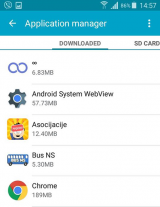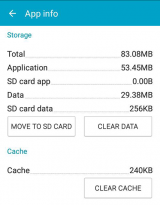Running out of disk space / no space left (MicroSD)
In order for our computer, smartphone, or tablet to work properly, they need free disk space. Our operating system, and apps write instructions, and leave data so that it can be reused in future, making them work faster. For example, when you open apps like Facebook, Twitter, Messenger, or any other app, the first time you are asked to log in, configure the app, and need to wait a bit for your data to load. These apps will open faster the next time you open them.
The solutions listed below will show you how to get more disk space. They apply to computers running on Windows (Asus, Acer, Dell, Lenovo, HP, and more), macOS (iMac, MacBook, Mac, Mac mini), as well as on smartphones and tablets running on Android OS (Samsung, Huawei, Xiaomi, Sony, OnePlus, etc.), and iOS (iPhone, iPad). All you need to do is to follow the instructions carefully.
-
Move apps to the microSD card
0(1)0(0)If you have a microSD card, and if your device is running low on disk space, consider moving the applications to your SD card, by following the steps below:
- Go to Settings;
- Open the Application Manager;

- Select the app you want to move to the microSD card;
- Tap on Move to SD card;

Do note that you won't be able to move all the apps, especially apps that are part of the Android operating system.
Important: Having apps installed on the microSD card increases the risk of you losing them, if something goes wrong with the microSD card.
More infos
-
Upload digital media
0(3)0(0)The improvement of smartphones and tablets also brings improvement of cameras. An unfortunate "side effect" of improved photo quality is that more memory will be used per photo and video. If the memory limit is reached, then the operating system will be unable to function.
To clean up disk space, you can upload photos and videos to a cloud storage service. Such services include Google Drive, OneDrive, Dropbox, and many more.
Note: Feel free to check out the guide on how to back up your documents from mobile devices.
More infos
-
Use DiskUsage
0(2)0(0)The DiskUsage app is one of the tools that can help you with identifying and removing all the files that are taking up the most space. Install the app, run it, and it will provide you with a detailed overview of your device's memory, allowing you to make an informed decision.
More infos Like Solutionbay?
Like Solutionbay?
Also check out our other projects :) See all projects -
Move personal data to MicroSD card
0(0)0(0)Too much personal data in the device's memory can slow it down and make it useless. Every operating system requires free space so that it can function properly. When you don't have much space on it, your device will notify you.
If your phone supports an MicroSD card you can move your personal data (images, videos, sounds and other files, which are by default stored in the device's memory) to the microSD card.
To move files to microSD card, follow the steps below (the steps may differ from one device to another:
- Go to Settings and tap on Storage;
- Tap on Transfer data to SD card;
- Check the boxes next to the type of files you want to transfer (e.g. photos, apps, videos) and tap on the Transfer button.
Not all Android devices have this option, and if yours doesn't have it too, you'll need to manually move the files. Open your File Explorer/Manager application and start searching for videos, images and sounds. Tap on it (or on several personal files) and select Move. File Managers come pre-installed in your mobile device.
Also, you can move files by connecting your mobile device to the computer. Cut personal data from Phone Memory and paste the cut files into the Memory Card partition.
Note: DO NOT MOVE OTHER FILES THAN PICTURES, VIDEOS, SOUNDS, PERSONAL DOCUMENTS, BECAUSE YOU CAN ACCIDENTLY MOVE PART OF A SYSTEM FILE AND CAUSE SYSTEM INSTABILITY.
More infos
-
Move personal data to MicroSD card − Windows phone
0(0)0(0)If your mobile device supports MicroSD cards, consider moving personal data files to it (photos, videos, music). Too much photos, videos, music can decrease your device's performance once it runs out of memory. The operating system needs free space in order to work properly.
To move personal data files to a MicroSD card:
Storage sense -> Phone -> select a category of files you want to manage (e.g. pictures, videos, sounds) and tap on it -> Select the file you want to move (or tap on the select button
 if you want to move more files than one) -> tap on "..." -> Save to SD card
if you want to move more files than one) -> tap on "..." -> Save to SD cardNote:
Windows phone OS (8 and higher) allows you to save file directly to the MicroSD card:Open Storage Sense from the apps list -> Store new apps on -> Change it to SD Card
Also, you can download the official Windows Phone file manager called Files from the Windows store, and manage the files through it.
Note 2: Not every file can be moved to the MicroSD card, because there are files which are system protected
More infos
-
Move applications to microSD card − Windows phone
0(0)0(0)Too much applications installed in your device's internal memory may slow it down, since the operating system requires free memory in order to function properly. If your device supports a MicroSD card, move the applications to it.
To move applications to MicroSD card:
Tap on Storage Sense from the Apps list (swipe to the left to access the list) -> Phone -> Apps + games -> Tap the application you want to move (or tap the select button to move more than one application -> tap on "..." -> Move to SD
Note: Not every application can be moved to the MicroSD card because there are some system applications which must be in the device's internal memory.
More infos
-
Delete unnecessary data − Windows phone
0(0)0(0)If you have too much photos, music, videos, games and other memory-consuming content stored on your mobile device, it's no wonder why your mobile device is slow.
To speed it up, you need to free up some space. You can improve it by deleting unnecessary personal data files (photos, videos, music, etc.). You can delete them either through the respective viewer applications (picture, music, video), or from Storage Sense:
From the Apps list (swipe to the left) open Storage Sense -> Phone -> Select a category of files (photos, videos, sounds) -> Manage -> Tap the select icon
 -> Select photo(s) -> Tap on Delete (the recycle-bin icon)More infos
-> Select photo(s) -> Tap on Delete (the recycle-bin icon)More infos
-
Delete text messages − Windows phone
0(0)0(0)Too much text messages can slow down your device because they occupy your its memory. To delete messages:
Go to Messaging from the Apps list (swipe to the left)-> tap and hold the message or thread you want to delete (or tap to the left of the message or thread, if you want to delete more messages)-> Delete
Note: Deleting threads with only text-based messages won’t free up much space on your device, so, concentrate on messages that include a lot of images, videos and voice notes.
More infos Like Solutionbay?
Like Solutionbay?
Also check out our other projects :) See all projects
Login to Solutionbay
Join Solutionbay
Please click on the confirmation link we just sent you to
If you don’t receive the email in the next 2 minutes please check your junk folder, and add [email protected] to your safe sender list.

